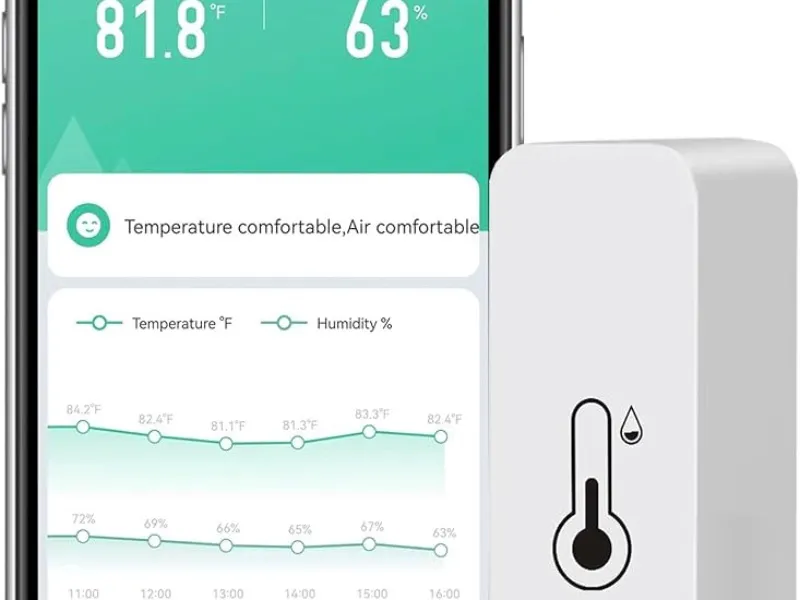- A humidity sensor, also known as a hygrometer or moisture sensor, is an instrument designed to measure the amount of moisture in the air.
- Humidity sensors are indispensable tools that play a critical role in ensuring the efficiency and safety of various systems and processes. Their ability to provide real-time, accurate humidity measurements is vital for several reasons.
In an age where precision and efficiency are paramount, understanding environmental conditions is crucial across various industries. One critical device that facilitates this understanding is the humidity sensor. This often-overlooked instrument plays a vital role in monitoring and managing moisture levels in the environment. But what exactly is a humidity sensor, and why is it so significant?
Understanding humidity sensors
A humidity sensor, also known as a hygrometer or moisture sensor, is an instrument designed to measure the amount of moisture in the air. It detects relative humidity (RH), which is the percentage of moisture in the air relative to the maximum amount the air can hold at a given temperature. The sensor converts this measurement into an electrical signal that can be displayed or recorded.
Also read: Discovering colocation: The secure haven for your business data
Also read: Colocation facilities: The heart of efficient data centre operations
Key components and functionality
The functionality of humidity sensors hinges on three essential components: the sensing element, the transducer, and the output interface.
Firstly, the sensing element forms the core of the sensor, and most humidity sensors use materials such as polymers, ceramics, or metals for this purpose. These materials are adept at absorbing moisture, which causes them to alter their electrical resistance or capacitance in response to changing humidity levels. This change is crucial for the sensor’s operation.
Subsequently, the transducer plays a vital role by converting the variations in the sensing element into an electrical signal. This signal transformation is essential for the sensor to communicate the humidity levels accurately.
Finally, the output interface processes the converted signal and presents it through various means. Depending on the sensor design, this output may be delivered as analog voltage, digital communication, or even through wireless systems, enabling the data to be utilised effectively in various applications.
Why humidity sensors matter
Humidity sensors are indispensable tools that play a critical role in ensuring the efficiency and safety of various systems and processes. Their ability to provide real-time, accurate humidity measurements is vital for several reasons.
Firstly, by controlling humidity, these sensors help improve air quality by preventing issues such as mold growth and dust mites, which contribute to healthier indoor environments.
In industries like food and pharmaceuticals, maintaining appropriate humidity levels is essential for preserving product quality and ensuring effective quality control.
Additionally, precise humidity control can significantly enhance productivity and efficiency in manufacturing and agriculture by creating optimal conditions for processes and growth.
In consumer electronics and HVAC systems, humidity sensors contribute to maintaining comfortable and healthy living conditions.
Humidity sensors are crucial across a wide range of applications, from everyday consumer products to complex industrial systems, as they provide accurate measurements and enable precise control over environmental conditions, thereby contributing significantly to overall efficiency, quality, and well-being.
Industrial Applications and Examples
Humidity sensors find indispensable applications across diverse industries, demonstrating their versatility and importance. For instance, in climate control and HVAC systems, Honeywell’s HIH-4000 Series is extensively utilised to regulate humidity levels, ensuring both comfort and system efficiency. By maintaining optimal humidity, these systems can prevent issues such as mold growth and enhance indoor air quality.
Similarly, in agriculture, the DHT22 sensor by Aosong Electronics is employed in precision agriculture for monitoring humidity levels within greenhouses. This precise control of humidity is crucial for managing plant health and optimising growth conditions.
In industrial settings, Sensirion’s SHT3x Series is used across various applications, including pharmaceutical manufacturing, where it is vital for maintaining specific humidity levels to ensure product quality and process stability. Consumer electronics also benefit from humidity sensors; Bosch’s BME280 sensor is commonly found in weather stations and smart home devices, providing comprehensive environmental data by measuring humidity, temperature, and pressure.
In the food and beverage industry, the Texas Instruments’ HDC2080 sensor is utilised in food processing plants to monitor humidity levels in storage facilities, thereby preserving food quality and extending shelf life.
In the automotive sector, Continental’s HUMIDITY SENSOR integrated into modern vehicles helps manage cabin climate and prevent window fogging, which enhances driver comfort and safety.
In the medical and pharmaceutical fields, E+E Elektronik’s EE240 sensor is crucial for maintaining sterile environments and ensuring the integrity of medical products through precise humidity control.

